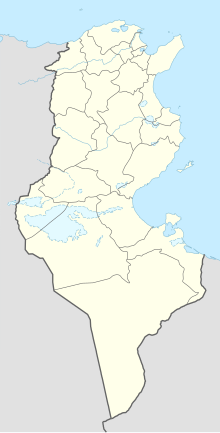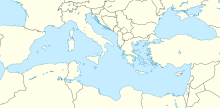| Battle of Zama | |||||||
|---|---|---|---|---|---|---|---|
| Part of the Second Punic War | |||||||
| |||||||
| Belligerents | |||||||
| Rome | Carthage | ||||||
| Commanders and leaders | |||||||
| Publius Cornelius Scipio | Hannibal | ||||||
| Strength | |||||||
|
c. 30,000
|
40,000 or 50,000
| ||||||
| Casualties and losses | |||||||
| At least 1,500 killed |
| ||||||
Location within Tunisia | |||||||
The Battle of Zama was fought in 202 BC in what is now Tunisia between a Roman army commanded by Scipio Africanus and a Carthaginian army commanded by Hannibal. The battle was part of the Second Punic War and resulted in such a severe defeat for the Carthaginians that they capitulated, while Hannibal was forced into exile. The Roman army of approximately 30,000 men was outnumbered by the Carthaginians who fielded either 40,000 or 50,000; the Romans were stronger in cavalry, but the Carthaginians had 80 war elephants.
At the outset of the Second Punic War, in 218 BC, a Carthaginian army led by Hannibal invaded mainland Italy, where it campaigned for the next 16 years. In 210 BC Scipio took command of the faltering Roman war effort in Iberia (modern Spain and Portugal) and cleared the peninsula of Carthaginians in five years. He returned to Rome and was appointed consul in 205 BC. The following year his army landed near the Carthaginian port of Utica. The Carthaginians and their Numidian allies were repeatedly beaten in battle and the Roman ally Masinissa became the leading Numidian ruler. Scipio and Carthage entered into peace negotiations, while Carthage recalled armies from Italy commanded by Hannibal and Mago Barca. The Roman Senate ratified a draft treaty, but when Hannibal arrived from Italy, Carthage repudiated it. Hannibal marched inland to confront the Romans and a battle quickly ensued.
The fighting opened with a charge by the Carthaginian elephants. These were repulsed, some retreating through the Carthaginian cavalry on each wing and disorganising them. The Roman cavalry units on each wing took advantage to charge their counterparts, rout them and pursue them off the battlefield. The two armies' close-order infantry were each deployed in three lines. The first two lines engaged each other and after a hard-fought combat the Carthaginians were routed. The second Carthaginian line then fanatically assaulted the Roman first line, inflicting heavy losses and pushing it back. After the Romans committed their second line the Carthaginians were forced to withdraw. There was a pause, during which the Romans formed a single extended line, to match that of the Carthaginians. These two lines charged each other, according to the near-contemporary historian Polybius "with the greatest fire and fury". The fight continued for some time, neither side gaining the advantage. The Roman cavalry then returned to the battlefield and charged the Carthaginian line in the rear, routing and destroying it. Carthage was left with no army with which to continue the war. The peace treaty dictated by Rome stripped Carthage of its overseas territories and some of its African ones. Thereafter, it was clear that Carthage was politically subordinate to Rome.

